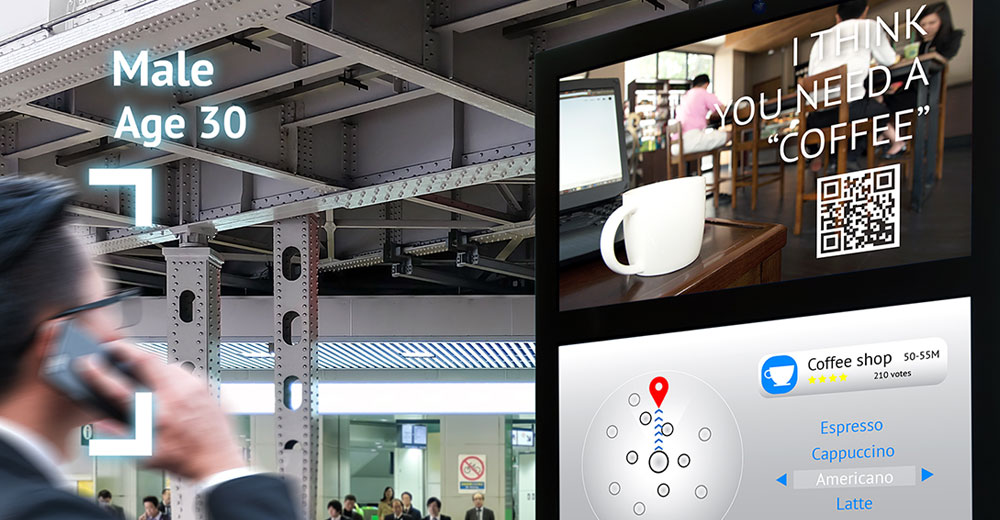To better market and cater to customers’ needs, brands can offer digital signage platforms that go beyond hearing and seeing information to touch and engage products in new ways within physical locations.
Digital signage itself is not radically new. The concept has existed for many years to provide targeted information, entertainment, merchandising, and advertising at retail or business locations. What is new, however, are the improved features and artificial intelligence behind the network delivery.
At first, the process involved using a network of interconnected digital displays that business owners managed from a central location. This flexibility allowed them to adjust messaging to match the needs of any given audience or time frame at their physical locations. Now, AI is plugged into the platform to offer personalized sales, customer service, and more immersive shopping experiences on-site.
Smart AI Marketing Messages
According to Christian Armstrong, a senior director of business development at the digital signage company Spectrio, digital signs that use AI have content that is 50% more relevant to their target audience and can spur greater interaction.
Sometimes called electronic signage, it refers to display technologies like LED walls, projection, and LCD monitors that vividly display webpages, videos, directions, restaurant menus, marketing messages, or digital images.
These commercial-grade TV screens operate continuously as large video walls, large-format screens, or smaller screens on top of a shelf at a point of purchase.
For digital signage to be effective, it must be compelling enough to grab the attention of on-premises shoppers and keep them off their mobile phones while searching for competitive pricing. When executed correctly, digital signage keeps customers fully engaged in the marketing messages as they walk around the store.
“The focus in a retail store should be keeping the phone in the shoppers’ pockets and engaging with that audience at the point of purchase,” he told the E-Commerce Times.
The Dynamic Marketing Advantage of Digital Signage
Armstrong offered that using digital signage in traditional physical stores is gaining popularity. When he first got involved with this marketing method some 20 years ago, most people considered it a foreign concept.
“Much of its use today is experience-driven. As retailers get smarter and the technology improves, we are introducing things like computer vision and analytics that trigger content based on specific scenarios,” he noted.
Quick-serve restaurants provide a prime example of how effective digital signage can be. Think Starbucks, for instance.
While you wait in a long line, Starbucks can change the menu display on the spot to promote products that are faster to make, fulfill orders faster, and get people out the door. Then, when the line gets shorter, the display can change to promote more high-margin items that may take a little longer to make.
In other scenarios, quick-serve establishments can show menu items along with motion graphics, engaging people to buy certain products and services.
“When you have static menu boards, there is really no way to influence that decision at the point of sale. With digital menu boards, our analytics technology lets the merchant see how long the line is in real time using just a simple radar scanner. We can change what content is playing on the screen just on that line,” explained Armstrong.
How AI Makes Better Marketing
A vital part of the added feature sets now coming to digital signage platforms is the measurement component. AI lets retailers leverage all the data the digital platforms collect, making intelligent decisions to help them make better content decisions.
Two examples built into Spectrio’s offering are non-obtrusive radar technology and computer vision. The radar component recognizes who walks past the display and how long they stand there engaging with that screen. A camera within the screen identifies the demographics of the individuals, their age ranges, and even their sentiments — as in what mood they are in when looking at a piece of content.
Why is this essential?
The AI extrapolates that data, ties it into what content played at a given time, and provides that dataset to a retailer. Armstrong added that it could include the number of products sold based on people looking at that product on the screen and what content was playing.
“This is very similar to how retailers already measure the effectiveness of their online content. It allows management to influence the decisions in the store in real time,” said Armstrong.
The store owner on-site or a pre-programmed control at corporate headquarters can control how the interactions work because Spectrio’s technology is all cloud-based and accessible through a web browser.
“If you have your content available, if it’s a video or an image, changing the screen display is as quick as dragging and dropping it into your playlist and getting someone who creates the videos,” noted Armstrong.
Unique Blend of Content, Creativity, Analytics
What makes Spectrio unique compared to other digital signage software providers is the company’s strong focus on the content going to those screens. The company employs a separate creative department that produces about 8,500 assets for a variety of applications involving both media and digital signage.
According to Armstrong, Spectrio can also measure the effectiveness of that content using radar and computer vision on-site. The company then works with its platform subscribers to improve the quality of that content and how it engages customers. The goal is to solve the organization’s communication challenges.
“We are having a lot of conversations with some pretty large retail brands these days. A lot of the focus and the hype around it has been our ability to combine three pillars — the delivery of the content, the actual content itself, and then measuring and improving. We are starting to see a ton of traction from that across many different facets of retail,” concluded Armstrong.























































